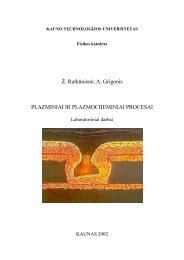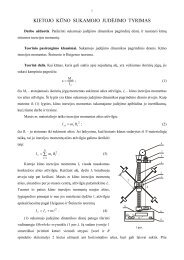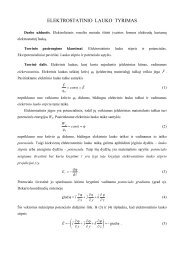PROCEEDINGS OF THE 7 INTERNATIONAL ... - Fizika
PROCEEDINGS OF THE 7 INTERNATIONAL ... - Fizika
PROCEEDINGS OF THE 7 INTERNATIONAL ... - Fizika
Create successful ePaper yourself
Turn your PDF publications into a flip-book with our unique Google optimized e-Paper software.
MEDICAL PHYSICS IN <strong>THE</strong> BALTIC STATES 7 (2009)<br />
Proceedings of the International Conference “Medical Physics 2009”<br />
9 - 10 October 2009, Kaunas, Lithuania<br />
RECENT ADVANCES AND TRENDS IN<br />
MEDICAL X-RAY AND MOLECULAR IMAGING<br />
Sören MATTSSON<br />
Medical Radiation Physics Malmö, Lund University, Malmö University Hospital, SE-205 02 Malmö, Sweden<br />
Abstract: This paper is intended to give an overview of clinically used imaging methods with special reference to<br />
digital techniques and 3D techniques for X-ray and nuclear medicine/molecular imaging such as CT, SPECT and PET.<br />
The paper will focus on recent advances and trends.<br />
Keywords: Medical imaging, tomography, X-ray, CT, PET, MRI, tomosynthesis, hybrid imaging<br />
1. Introduction<br />
Medical imaging is an invaluable part of modern health<br />
care. It is used for disease detection, classification,<br />
prognostic staging and to validate therapeutic response.<br />
In fact, recent advances in imaging technology have<br />
redefined how physicians diagnose and treat some of<br />
the most life threatening diseases like cancer and heart<br />
disease, and have nearly eliminated the need for<br />
exploratory surgery. Good images are the base for<br />
planning of therapies such as surgery and radiotherapy.<br />
Imaging is also an important instrument for clinical<br />
research, where the requirements for quantitative and<br />
reproducible image data are especially high.<br />
Clinical diagnostic imaging is currently using five<br />
major modalities: 1) Planar X-ray imaging, 2)<br />
computed tomography (CT), 3) magnetic resonance<br />
imaging (MRI), 4) nuclear medicine imaging (using<br />
planar gamma cameras, single-photon-emissioncomputed<br />
tomography (SPECT) and positron-emission<br />
tomography (PET)) and 5) ultrasound.<br />
This paper will concentrate on X-ray and nuclear<br />
medicine imaging – methods that use ionising<br />
radiation. These techniques are currently undergoing<br />
major improvements and a change towards<br />
technologies that facilitate quantitative tomographic<br />
imaging.<br />
2.1 Planar X-rays<br />
2. X-ray imaging<br />
X-ray imaging is still based on the X-ray tube as<br />
radiation source. Tungsten is the most common anode<br />
6<br />
material, except for mammography, which use Mo- and<br />
Rh- anodes. Filters of Al, Cu, Mo, and Rh are used to<br />
cut off different parts of the photon energy distribution.<br />
Currently used X-ray tubes are very efficient radiation<br />
sources. They have, however, shortcomings as high<br />
operating temperature. With a new cooling principle<br />
utilizing convective cooling, the need for waiting times<br />
due to cooling has been reduced. Moreover, an<br />
electronic beam deflection system for focal spot<br />
position and size control has opened for advanced<br />
applications. The ongoing nanotechnology based field<br />
emission X-ray source technology (Xintek,<br />
www.xintex.com), enables the generation of radiation<br />
with fine control of the spatial distribution of the Xrays<br />
and temporal modulation of the radiation [1]. The<br />
technology also enables the design of gantry-free<br />
stationary tomography imaging systems with faster<br />
scanning speed and potentially better imaging quality<br />
compared to today’s commercial tomographic systems.<br />
For the detection and imaging of the X-rays transmitted<br />
through the patient, flat-panel detectors have been<br />
developed for use in radiography and fluoroscopy to<br />
replace standard X-ray film, film-screen combinations<br />
and image intensifiers. Current technology use flatpanel<br />
detectors, made from evaporated CsI or Gd2O2S<br />
on a matrix of a-Si photodiodes for higher energies or a<br />
layer a-Se, directly converting the absorbed energy to a<br />
current for low energies (mammography).<br />
The development of detectors for planar X-ray imaging<br />
has resulted in increased detection efficiency without<br />
significant loss of spatial resolution.<br />
The availability of flat panel detector technology has<br />
also stimulated a number of new developments for<br />
tomographic imaging (See section 2.2).








